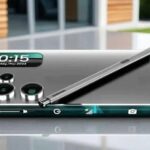In a move set to redefine the boundaries of smartphone photography, Samsung has announced three groundbreaking image sensors. Unveiled on June 27, 2024, these new sensors – the ISOCELL HP9, ISOCELL GNJ, and ISOCELL JN5 – promise to elevate mobile imaging to new heights. Let’s dive into what these innovations mean for the future of smartphone cameras and the photos we take with them.

ISOCELL HP9: Zoom Like Never Before
The star of Samsung’s new lineup is undoubtedly the ISOCELL HP9. This sensor breaks new ground as the industry’s first 200-megapixel (MP) sensor designed specifically for smartphone telephoto cameras. Here’s why this is a big deal:
- Unprecedented Zoom Capabilities: With such a high resolution, the HP9 promises to deliver stunningly detailed zoomed-in photos.
- Enhanced Video Recording: The sensor’s high pixel count could also translate to clearer, more detailed video recordings, especially when zooming.
- Potential for Computational Photography: Such a high-resolution sensor opens up new possibilities for computational photography techniques, potentially allowing for even better digital zoom and post-processing capabilities.
The ISOCELL HP9 could be a game-changer for smartphone photography enthusiasts who have long desired DSLR-like zoom capabilities in their pocket-sized devices.
ISOCELL GNJ: Elevating Overall Image Quality
While the HP9 focuses on zoom, the 50MP ISOCELL GNJ aims to improve overall image quality across various shooting conditions:
- Advanced Pixel Technology: Samsung promises cutting-edge pixel tech that could lead to significant improvements in image quality.
- Better Low-Light Performance: Improved sensor technology often translates to better light gathering capabilities, which could mean clearer, brighter photos in challenging lighting conditions.
- Reduced Artifacts: The GNJ sensor is designed to minimize unwanted artifacts in photos, leading to cleaner, more professional-looking images.
- More Accurate Colors: Improved color reproduction could lead to more true-to-life photos that better capture the scene as our eyes see it.
The ISOCELL GNJ seems poised to become the new go-to sensor for main cameras in high-end smartphones, offering a balanced approach to high-quality imaging in various scenarios.
ISOCELL JN5: Consistency Across All Lenses
Rounding out the trio is the ISOCELL JN5, a sensor focused on delivering a consistent camera experience across all lenses in a smartphone’s camera array:
- Broad Color Range: This sensor aims to capture a wide range of colors accurately, ensuring vibrant and true-to-life images.
- Improved Autofocus: Enhanced autofocus capabilities could lead to sharper images and better performance in capturing moving subjects.
- Consistent Quality: By providing similar performance across different lenses, the JN5 could ensure that users get great photos regardless of which camera they’re using on their phone.
The ISOCELL JN5 addresses a common complaint among smartphone users – the often noticeable difference in quality between main, ultra-wide, and telephoto lenses. This sensor could help create a more unified and reliable camera experience.
The Bigger Picture: What This Means for Smartphone Photography
Samsung’s announcement of these new sensors signals a significant leap forward in smartphone imaging technology. Here’s what this could mean for the future of mobile photography:
1. Closing the Gap with Dedicated Cameras
With features like the 200MP telephoto sensor, smartphones are inching ever closer to the capabilities of dedicated cameras. This could further accelerate the trend of consumers relying solely on their phones for photography needs.
2. Improved Low-Light Photography
Advancements in sensor technology, particularly with the ISOCELL GNJ, could lead to significant improvements in low-light performance. This has long been a challenging area for smartphone cameras.
3. More Versatile Camera Systems
The combination of high-resolution zoom capabilities and consistent performance across lenses could result in more versatile smartphone camera systems. Users might find themselves able to capture a wider range of scenes and subjects effectively.
4. Potential for New Features
High-resolution sensors like the HP9 open up possibilities for new computational photography features. We might see innovations in areas like digital zoom, image stabilization, and multi-frame processing.
What’s Next: The Road to Implementation
While the announcement of these sensors is exciting, there are still some unknowns:
- Device Integration: We don’t yet know which specific smartphones will be the first to incorporate these new sensors.
- Timeline: The timeline for when we’ll see these sensors in consumer devices remains unclear.
- Real-World Performance: As with any new technology, the true test will come when these sensors are implemented in actual devices and tested in real-world conditions.
It’s likely that we’ll see these sensors debut in high-end Samsung smartphones first, potentially in their next Galaxy S or Galaxy Note series. Other manufacturers who use Samsung sensors might also incorporate them into their devices in the future.
Conclusion: A Bright Future for Smartphone Photography
Samsung’s announcement of the ISOCELL HP9, GNJ, and JN5 sensors represents a significant step forward in smartphone imaging technology. These innovations promise to push the boundaries of what’s possible with mobile photography, offering improvements in zoom capabilities, overall image quality, and consistency across different lenses.
As these sensors make their way into consumer devices, we can look forward to smartphones that are even more capable of capturing life’s moments with stunning clarity and detail. Whether you’re a casual smartphone photographer or a mobile imaging enthusiast, the future of smartphone cameras is looking brighter than ever.
Stay tuned for more updates as we eagerly await the first devices to feature these groundbreaking sensors. The next generation of smartphone photography is just around the corner, and it’s shaping up to be truly impressive.










Add Comment